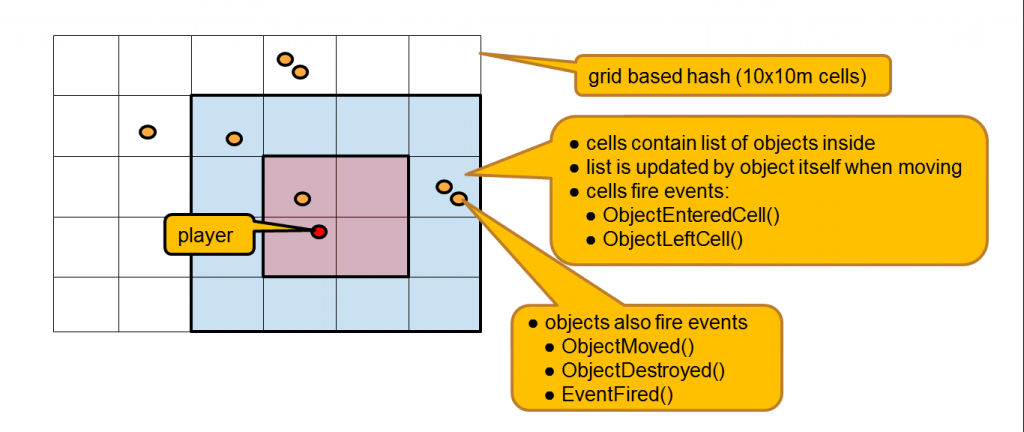This is the second article in my Albion Online series, the first part can be found here.
Interest Management
Interest Management is the ability to efficiently determine which game object can “see” which other objects at a given point in time. This is important for multiple reasons.
First of all, we want to minimize the network traffic for each client by sending the client only updates of objects it can actually see right now. Second, players do cheat. Any information that is sent to the client can and will be extracted by cheaters. That means we absolutely need to restrict client knowledge to objects that are on the screen or at least very close to it. The whole mechanism is also useful for many other purposes; for instance, monsters are activated when a player comes near and deactivated when the player leaves.
All this needs to be as efficient as possible. Let’s illustrate this with some numbers: A single (1×1 km) cluster may contain more than 300 players, 500 monsters and more than 10.000 other interactive objects (most of which are trees, because you can cut down every single tree in Albion Online).
 We achieve the efficiency by putting all objects into a grid-based hash. Each grid cell is roughly 10×10 meters and contains a list of objects inside. Very large objects may be in multiple cells at once but that is rare. The object itself is responsible for updating the hash if it moves. The grid cells fire events when objects are added or removed, so subscribing to these events already gives you a very efficient way of monitoring an area.
We achieve the efficiency by putting all objects into a grid-based hash. Each grid cell is roughly 10×10 meters and contains a list of objects inside. Very large objects may be in multiple cells at once but that is rare. The object itself is responsible for updating the hash if it moves. The grid cells fire events when objects are added or removed, so subscribing to these events already gives you a very efficient way of monitoring an area.
Each player is surrounded by something we call an Interest Area. It consists of two grid-aligned rectangles. When an object enters the inner, smaller rectangle, the player will start “seeing” the object, i.e. the server will send the client an initial “new object” message (“look, a monster!”) and subscribe to the various event the object itself offers. Whenever the object does something interesting (e.g. the monster attacks someone) it will fire an event, that event will be forwarded to the Interest Area of the nearby player and the Interest Area will forward the event to the client.
 An object will be watched until it leaves the slightly larger blue area. When that happens, the client will receive an “object gone” message and stop receiving updates. The blue area is larger in order to keep the visible object set more stable over time.
An object will be watched until it leaves the slightly larger blue area. When that happens, the client will receive an “object gone” message and stop receiving updates. The blue area is larger in order to keep the visible object set more stable over time.
Very cool tech!!